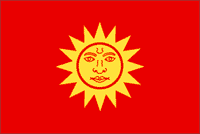- Kûch Behar
-
Cooch Behar
Ex-principauté de
Cooch Behâr
Fondateur Chandan Nârâyan Fondée en avant 1510 Dynastie Chauhan Religion hindoue Superficie 3 414 km² Salve 13 coups de canon La principauté de Cooch Behar se trouvait à quelque 400 km au nord de Calcutta au confluent du Brahmapoutre et de la Tîsta.
Bishwa Singha déplace la capitale de Chikna dans les montagnes à Hingulabas dans la plaine. Nar Nârâyan s'empare du Manipur et du Tripura les ajoutant à son royaume. Pran Nârâyan envahit Ghoraghat, le siège du pouvoir moghol au Bengale, puis en 1661 s'empare de Dhâkâ, mais est forcé de capituler et de signer un traité de paix en 1664. En 1665, le râja Mod Nârâyan aide avec 5 000 de ses hommes le râja Ram Singh, roi d'Amber et chef des armées du sultanat de Delhi, dans sa guerre contre le râja de l'Assam. Rup Nârâyan déplace à nouveau la capitale, qui changera de nom pour celui de Behar, de Atharokotha à Guriahati Gram sur la rive est de la Torsha.
Durant le règne de Debendra Nârâyan, l'administration de l'état s'effondre et le royaume est envahi par le Bhoutan dont il devient le vassal.
Avec l'aide des Britanniques en 1772, le royaume se libère du Bhoutan.
La principauté a intégré l'état du Bengale occidental.
Dirigeants : Mahârâja
- 1510 – 1523 : Chandan Nârâyan
- 1523 - 1554 : Bishwa Singha
- 1554 – 1587 : Nar Nârâyan
- 1587 – 1621 : Lakshmi Nârâyan
- 1621 – 1626 : Bir Nârâyan
- 1626 – 1665 : Pran Nârâyan
- 1665 – 1680 : Mod Nârâyan
- 1680 – 1682 : Vasudeo Nârâyan
- 1682 – 1693 : Mahendra Nârâyan
- 1693 - 1714 : Rup Nârâyan
- 1714 - 1763 : Upendra Nârâyan
- 1763 - 1765 : Debendra Nârâyan
- 1765 - 1770 : Dhairjendra Nârâyan (1er règne)
- 1770 - 1772 : Rajendra Nârâyan
- 1772 - 1775 : Dharendra Nârâyan
- 1775 - 1783 : Dhairjendra Nârâyan (2e règne)
- 1783 - 1839 : Harendra Nârâyan
- 1839 - 1847 : Shivendra Nârâyan
- 1847 - 1863 : Narendra Nârâyan
- 1863 - 1884 : Nripendra Nârâyan
- 1884 - 1911 : Nripendra Nârâyan
- 1911 - 1913 : Rajendra Nârâyan
- 1913 - 1922 : Jitendra Nârâyan
- 1922 - 1947 : Jagaddipendra Nârâyan
Voir aussi
Lien externe
Villes du sous-continent indien Villes du Bangladesh · Villes du Bhoutan · Villes de l'Inde · Villes des Maldives Villes du Népal · Villes du Pakistan · Villes du Sri Lanka Portail Monde indien ~ Index alphabétique ~ Index thématique 
Périodes L'Inde ancienne Le sultanat de Delhi Les grands Moghols La période Marathe L'Inde britannique Le Raj britannique Depuis 1947... Histoires nationales Histoire de l'Inde Histoire du Bangladesh Histoire du Bhoutan Histoire des Maldives Histoire du Népal Histoire du Pakistan Histoire du Sri Lanka Voir aussi États princiers des Indes Religions de l'Inde Méta Portail Monde indien Index alphabétique Index thématique Projet Monde indien Catégorie : Principauté des Indes
Wikimedia Foundation. 2010.
